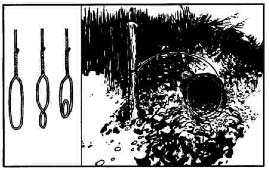MAKING A BASIC SNARE
A basic snare can be made from materials probably already in your home. They can also be purchased inexpensively from most sporting goods and outdoors retailers. If you choose to make your own snares, you can make snares capable of trapping animals of up to about 10 pounds using copper wire sourced from an old lamp or another appliance.

This wire (usually 18-2 gauge) provides enough material to construct multiple snares. If you don’t have an old appliance lying around, a quick trip to the hardware store should provide you with plenty of copper wire options of varying lengths and sizes.
Appliance wire is actually two strands of wire held together by insulation. The first step is to cut the wire into a two foot section (this makes it easier to work with). Next, split the two strands of wire. You should be left with two lengths of copper wire each two feet long. Use a sharp knife to peel back the layers of insulation from both strands of wire. You should notice that the copper wire is actually composed of multiple thin strands of copper.
Take care not to damage these fine strands of copper while removing the insulation.
Next, separate the strands in half again. Once finished, you’ll be left with four strands of copper wire that are the perfect thickness for making snares. Twist each strand together to compress the individual copper strands into a single, solid piece. You should twist each strand until it is about the size of a pencil lead. After twisting to size, cut off the ends and twist well to prevent the copper from unraveling in the future.
Now make a look the size of a dime in each end of all four strands of wire. One of these loops will attach to the anchor point and the other loop forms the noose.
Put one loop through the other to form the noose and then tighten the loop that forms the noose so there is just enough room for the wire to pass through when the snare is under tension.
Once you have completed these steps for all four strands, you will be left with four snares using only two feet of appliance wire. Make as many of these as you want and can carry. The more snares you set up, the better your chances of success assuming you place them properly (covered in a later chapter) and check them often as predators may stumble across your catch and consume it before you get a chance to check the traps.

